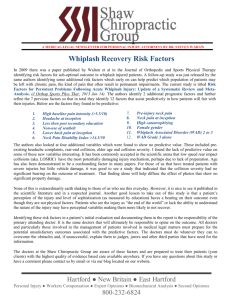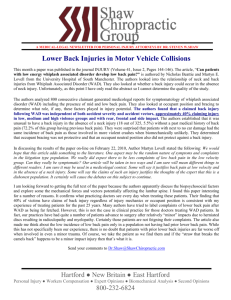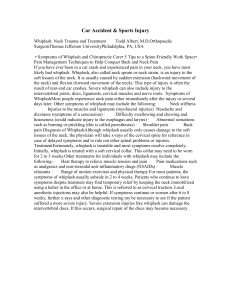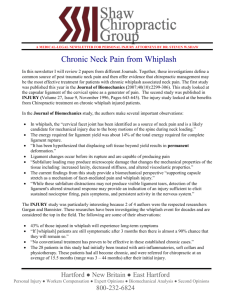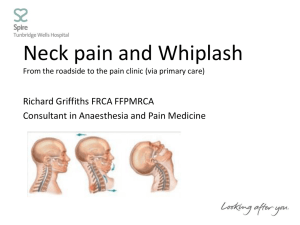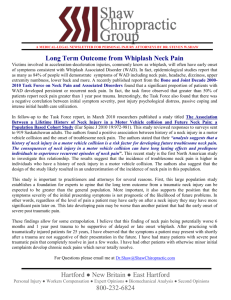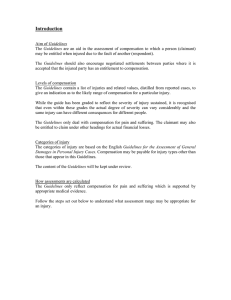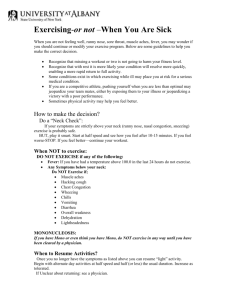Whiplash and Cervical Spine Disorders: Evaluation and
advertisement
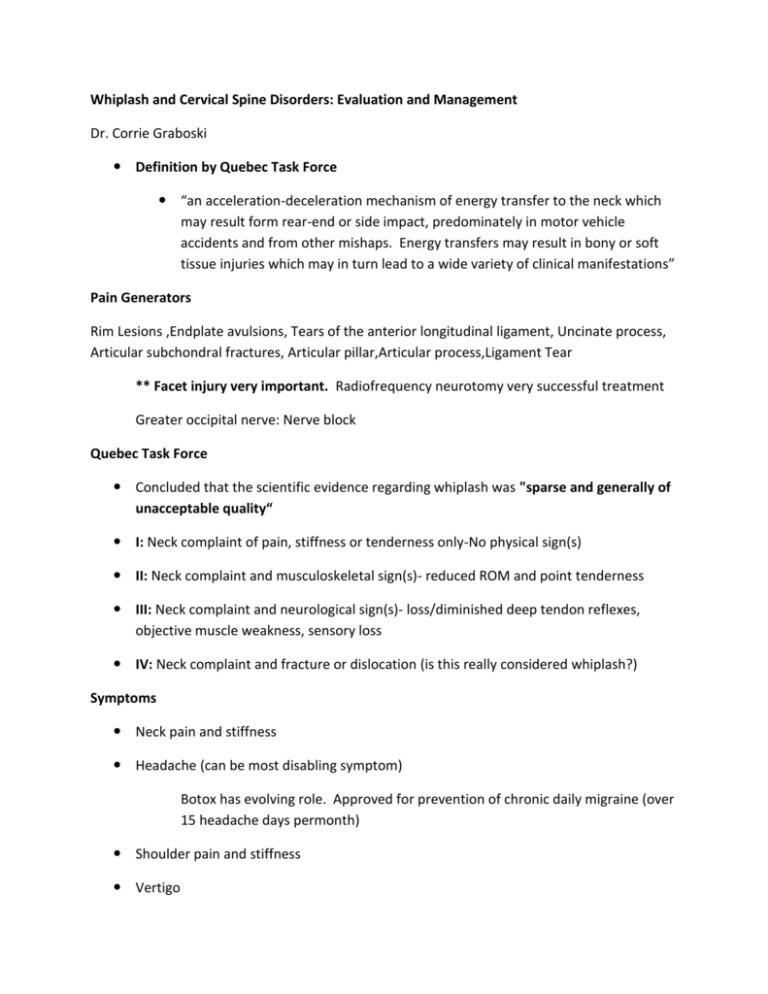
Whiplash and Cervical Spine Disorders: Evaluation and Management Dr. Corrie Graboski Definition by Quebec Task Force “an acceleration-deceleration mechanism of energy transfer to the neck which may result form rear-end or side impact, predominately in motor vehicle accidents and from other mishaps. Energy transfers may result in bony or soft tissue injuries which may in turn lead to a wide variety of clinical manifestations” Pain Generators Rim Lesions ,Endplate avulsions, Tears of the anterior longitudinal ligament, Uncinate process, Articular subchondral fractures, Articular pillar,Articular process,Ligament Tear ** Facet injury very important. Radiofrequency neurotomy very successful treatment Greater occipital nerve: Nerve block Quebec Task Force Concluded that the scientific evidence regarding whiplash was "sparse and generally of unacceptable quality“ I: Neck complaint of pain, stiffness or tenderness only-No physical sign(s) II: Neck complaint and musculoskeletal sign(s)- reduced ROM and point tenderness III: Neck complaint and neurological sign(s)- loss/diminished deep tendon reflexes, objective muscle weakness, sensory loss IV: Neck complaint and fracture or dislocation (is this really considered whiplash?) Symptoms Neck pain and stiffness Headache (can be most disabling symptom) Botox has evolving role. Approved for prevention of chronic daily migraine (over 15 headache days permonth) Shoulder pain and stiffness Vertigo Fatigue TMJ symptoms Arm pain Paresthesias Visual disturbances Myofascial Pain Syndrome (a talk on it’s own!) Large group of common painful muscle disorders Syndrome of pain, muscle spasm, tenderness, stiffness, decreased ROM, weakness and occasional autonomic dysfunction Characterized by trigger points, taut bands and local twitch response Trigger point injections with local anesthetic very useful Dry needling such as effective, but a bit more painful No role for injecting Botox or steroids Investigations: None often needed In acute injury follow Canadian C spine rules Generally not possible to make diagnosis in acute phase even with expensive modalities X-rays normal or slight flattening of normal lordotic curve (no prognostic value) Bone scan useful to rule out pathology and to plan interventional procedures (but “cold” bone scan does not prevent trial of medial branch block/radiofrequency neurotomy MRI of brain and neck normal EMG/Nerve conduction studies The only functional test of nerve root Rule out other causes of numbness and tingling ie CTS Where’s the Science? Studies before 1980 are methodologically very poor; unfortunately this is where we get the foundations for our ideas on whiplash Animal models in which we base much of our knowledge of pathophysiology are flawed. Monkeys hurtled at great speeds with brain and spinal cord hemorrhages/contusion, often in coma for several hours Cochrane review 2007: insufficient evidence to assess effectiveness of commonly used medications or home exercise programs for the treatment of acute neck pain. Evidence for spinal manipulation is similarly limited Bottom line Evidence for methylpredniolone IV infusion (1 study) Evidence for trigger point injections with lidocaine (not Botox) Some evidence for epidural steroid injections in those with arm pain Very little studies to look at medications Questionable evidence for flexeril or benzos or NSAIDs No other good medication studies We have lots of good studies for low back pain for TCA’s, opioids, antiepileptics. Can we apply this research to the neck? Largest review of Literature for Treatment of WAD: Teasell 2010 The therapies that have been advocated for patients with WAD are quite diverse, which likely reflects several factors including the variable nature of WAD, our incomplete understanding of the disorder and the absence of any one treatment distinguishing itself as the most effective… While several conclusions were reached in the present review, there is a lack of research investigating the efficacy of interventions for patients at any stage on the WAD continuum. Clearly, further research is needed to determine which treatments are most effective at reducing the disabling symptoms associated with WAD.” Treatment for Acute Whiplash Exercise programs, active mobilization, advice to act as usual improve recovery Limited evidence for Pulsed electromagnetic field therapy Methylprednisolone infusion Evidence does not support Education Laser acupuncture Immobilization with soft collars may actually impede recovery In general, “the longer the delay between injury and the commencement of therapy, the greater the risk that patients will go on to develop chronic symptoms.” Treatment for Chronic Whiplash Exercise programs Interdisciplinary Interventions Especially CBT Limited evidence for Manual joint manipulation Myofeedback training No evidence for “alternative” therapies (Gestalt, Rosen bodywork, and craniosacral) Australia guidelines: no evidence cervical pillow Medications: Tricyclic antidepressants SNRIs Gabapentin Pregabalin Well designed trials for neck pain are lacking and the literature is more robust for neuropathic pain states I don’t see role of Baclofen: This is for central spasticity ie post stroke Interventional Procedures Strong evidence for Radiofrequency Neurotomy (we have some incredible interventional radiologists in Victoria) Temporary relief only Denature nerves involved in chronic pain of whiplash McDonald Neurosurgery 1999 28 patietns 71% reported long term complete relief of their pain Median duration of pain relief of successful cases was 422 days No role for intra articular steroid injections Conflicting evidence for BTXA Role of Exercise Spinal manipulation therapy more effective than medication in short and long term Home exercise program equivalent to spinal manipulation Gentle stretches, neck flexor strengthening Evidence that aggressive strengthening can be detrimental Australia Guidelines 2008 (found on MD Consult) ** Fantastic resource History: Psychological coping Self Efficacy Scale or Coping strategies questionnaire Routine measure of pain intensity Visual analogue score >7/10 poor prognostic sign Measure of disability Neck Disability Index >40 poor outcome Physical Exam Posture Palpation of neck Neuro exam (strength, sensation, reflexes) Co-morbid injuries Psychological state Extras... Cervical flexor muscle control Widespread sensory hypersensitivity, especially sensitivity to cold Prognostic factors Poor if initial VAS >7/10 or NDI >40 On going pain Poor education Psychological factors (tested via SES or CSQ) Low self efficacy Catastrophizing Anxiety No radiological factors help predict Regular review and earlier referral to specialist Cognitive Behavioural Therapy (treat all aspects of Pain) www.painbc.ca/resources-for-health-care-providers My opinion Goal is to work towards an ACTIVE rehab program No reliance on passive therapies (acute pain control to let you do the work) IMS, trigger point injections Aerobic exercise Core stability Pool therapy Multidisciplinary rehab Key References Teasell “A reseach synthesis of therapeutic interventions for Whiplash” Pain Res Manag 2010 15 (5) 287-295 Peloso et al Medicinal and injection therpies for mechanical neck disorders. Cochrane Database 2007 Whiplash and Other Useful Illness Andrew Malleson State of the Art Reviews Spine May 1998 Australia Guidelines to Whiplash 2008 from MD Consult Wallis B et al. Resolution of psychological distress of whiplash patients following treatment by radiofrequency neurotomy: a randomised, double-blind, placebo-controlled trial. Pain 1997;73:15-22.
